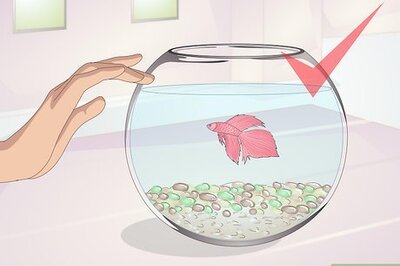
views
What are polygel nails?
Polygel nails use a hybrid formula for optimum durability and flexibility. The polygel nail polish formula is a new-ish contender in the world of manicures—but what is it? Polygel is a hybridized formula that borrows the strength of acrylic nails and combines it with the elasticity of a builder gel, giving it a similar flexibility to gel nails. The formula itself comes out in a toothpaste-like tube and can be applied directly to the nail. The polygel is then molded to the desired length and shape before being cured under a UV lamp. How are polygel nails different from gel nails? Polygel nails are stronger and less damaging than gel manicures, but they’re still lightweight. Plus, their formula can be more easily shaped, leading to more fun and creative options for a manicure. What about acrylic nails? Polygel doesn’t last as long as acrylic and isn’t quite as durable. However, polygel is lighter weight and won't harden right away like acrylics do, so nail techs have time to shape and style the nail to perfection before curing.
How to Apply Polygel Nails
It’s best to visit a professional nail tech for polygel nails. It’s much safer to visit a professional to get a set of polygel nails—plus, it’s more likely that your manicure will turn out better and last for longer! However, if you feel confident that you can apply polygel yourself, you can follow the set of steps below.
File your nails to smooth out any rough edges. Trim your nails, then take a soft-grit nail file and hold it perpendicular to the edge of your nail. File in single strokes along the grain of your nail, avoiding any type of sawing motion. Adjust the angle of your nail file to achieve a rounded shape, and make sure that any ragged edges are completely smoothed out.
Apply your base coat and cure it under an LED or UV light. Uncap the base coat included in your polygel nail kit and remove the brush from the bottle. Use light strokes to cover each of your fingernails with the base coat. Then, place one hand at a time under the included LED or UV light to cure the base. Leave each hand under the light for the amount of time specified in your kit’s package instructions.
Apply the slip or alcohol-based solution onto each nail. Uncap the slip or alcohol-based solution that’s included in your polygel nail kit. Dip the brush into the bottle, then neatly paint it onto each of your nails. This solution helps the polygel to move around on your nail without it sticking to your brush before curing.
Squeeze polygel onto your nail and sculpt it with a brush. Take the tube of polygel and squeeze a small amount onto your first nail. Use the included brush to spread the polygel evenly across your nail. Then, use the same brush to carefully sculpt the polygel into your desired shape. Remember that the polygel won’t harden until you cure it, so take all the time you need for sculpting!
Cure your nails underneath your UV or LED light to cure the polygel. Once you’ve achieved your desired polygel look on each nail, place each hand under the included UV or LED light. Keep your hand underneath the light until the polygel is fully cured and hardened. If you’re not sure how long this curing process will take, consult the package instructions on your polygel nail kit.
If needed, cut, file, and shape your nails to your perfect shape. If your polygel nails still have some rough or uneven edges, it’s not too late to shape them! Once the formula is fully cured, you can carefully cut or file your nails to further shape and smooth them out. Proceed gently so as not to break the polygel, and continue until you’re fully happy with the look of your nails.
Apply your top coat and cure your nails under the UV/LED light. Finally, brush the top coat from your polygel nail kit onto each of your nails. Place each hand under your UV or LED light for the amount of time designated on the kit instructions. Now, your top coat should be fully cured, and your polygel nails will be ready to show off!<
How to Remove Polygel Nails
Visit a nail tech, or use acetone and filing to remove your polygel. If you got your nails done by a professional at a salon, it’s advised to return to that salon to have your polygel removed—this approach is the least likely to damage your nails. If you used an at-home nail kit, however, you can follow the removal directions indicated on the package. Typically, polygel nail removal is done either with acetone or by filing down the nail (or a combination of both): Acetone Removal: Cut off any excess polygel with nail clippers and file down the shiny top coat with a nail file. Then, soak your nails in a bowl of acetone for 10-15 minutes and gently scrape away the loosened gel with a cuticle pusher. Buff away any residue with a nail file. Filing Removal: Cut off any excess polygel with nail clippers, then use a 100-grit nail file (or an e-file on low speed) to remove all but a thin layer of polygel. Use a buffing block or nail file to remove the final layer of polygel.
Cost of Polygel Nails
A full set of polygel nails costs between $60 and $150. While the price of polygel nails will vary based on your location, salon reputation, tech experience, design complexity, and more, a full set typically runs from $60-$150. When you go to get your nails redone every 2-3 weeks, these fills usually cost between $45 and $80.
Pros & Cons of Polygel Nails
Pros of polygel include fewer chemicals, less damage, and more creativity. Unlike acrylic nails, polygel is not harmful to inhale because it doesn’t contain as many harmful chemicals (like monomers) as traditional formulas. Therefore, it’s generally considered to be safer for both nail technicians and clients. Also, polygel nails that are correctly applied and removed have less potential to damage natural nails than acrylics do. They don’t have to be filed down quite as much as acrylics, and they’re made from a lighter material than acrylics and hard gels. Therefore, polygel nails place less stress on the natural nail. And, perhaps most importantly, polygel nails give you more room to play with shape and style! The formula can be formed into whatever shape you please, and it can continue to be tweaked until it is placed under the gel lamp.
Cons of polygel include the cost, UV exposure, and general upkeep. First of all, polygel nails tend to cost slightly more than acrylic and gel nails. Plus, they grow out after just a few weeks, so it’s important to get them filled in if you'd like to maintain the look. As a result, the repeated cost of getting the nails done by a professional can add up and become inconvenient. Also, polygel nails need UV or LED lights to cure. After prolonged exposure, these lights can be harmful and potentially cause aging skin or skin cancer.
How long will polygel nails last?
Polygel nails generally last for three weeks. Compared to gel nails and traditional manicures, polygel nails can last for quite a long time—up to three weeks, to be exact! Of course, this duration depends on the nails being properly applied by a professional nail technician, as well as the general maintenance of the nails by the wearer.
The Best Polygel Nail Kits
You can buy at-home polygel nail kits online or from most drugstores that sell beauty supplies. Most kits come equipped with everything you need for a polygel manicure—from a range of polishes and tools to a UV or LED light machine. You can choose whichever polygel nail kit catches your attention, starting with these top-rated options from Amazon: JEWHITENY Poly Extension Gel Nail Kit. Rated 4.0 stars with 6,853 reviews. Modelones Poly Extension Gel Nail Kit. Rated 4.0 stars with 1,141 reviews. GAOY Poly Gel Nail Kit. Rated 4.1 stars with 6,978 reviews.
Frequently Asked Questions About Polygel Nails
Should you do polygel nails at home? It’s generally not recommended to apply polygel nails at home unless you have experience with nail applications. While it’s possible to do your own polygel nails with an at-home kit, you could damage your nails or get a poor result if you don’t have a good understanding of nail application technique.
Do polygel nails need UV light? Yes, polygel nails need a UV (or LED) light in order to cure and harden. Otherwise, the polygel will not set or stay put at all on your nails.
How strong are polygel nails? Polygel nails are fairly strong and are unlikely to break easily when applied correctly. They’re considered to be similar to acrylics in terms of strength, but they’re also more lightweight and more natural-feeling than acrylics.
Are polygel nails good for your nails? Polygel is generally considered to be good for your nails, especially when compared to other formulas and applications. Polygel nails won’t ruin or damage your nails, especially if you visit a knowledgeable nail technician for your application and removal.




















Comments
0 comment